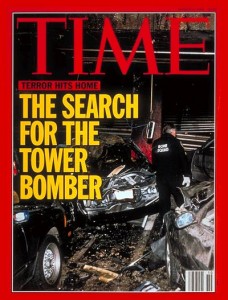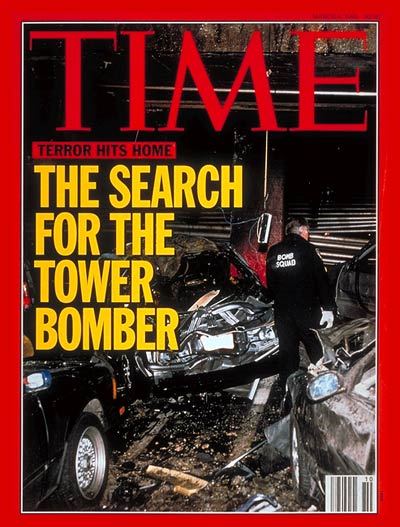By Glenn Carr
Christopher Carr was just checking in on his industrial gas supply company in New York on a snowy afternoon. It was February 26, 1993. “I was in the field riding along with our New York City sales manager Andy” he recalls “we were visiting accounts in Brooklyn, [when] we heard about the explosion at the World Trade Center.” [1] The World Trade Center had been the target of a terrorist attack that winter afternoon which would momentarily shock the nation and the City. Carr left his house in Fairfield, CT expecting an uneventful and routine day checking in on his business accounts. He got quite the opposite. After the news of the attack struck, Carr got even more than he bargained for that morning. “Within 5 minutes of hearing about it on the news, Andy’s pager started screeching on his belt he recognized the number as one of our largest account, Felix Contracting.” [2] Carr explained. Felix Contracting’s materials had been provided by Carr’s company. They supplied most of the welding supplies, torches, and cutting gases, throughout the five boroughs of New York City. “The project manager, his name escapes me, needed us to get a truck and deliver oxygen, acetylene, and cutting torch supplies immediately to the World Trade Center.” [3] Carr recalled. New York City had quickly become a victim of a hate crime. The question is how much did this crisis affect the city in the years after.
New York City was complete chaos after the bombing had occurred. There was a sense of sheer panic that overcame the seemingly invincible city. The World Trade Center was a major part of thousands of people’s everyday routine. As Brands puts it, “To strike a blow against the Twin Towers would be to register displeasure or outrage against America’s global power. The trade center, moreover, sat stop a train and subway station, through which hundreds of thousands of people passed daily.”[4] Brands captured the essences of the severity of the 1993 attack. The bombing greatly affected many New Yorkers and those that were visiting the city. Many were in shock and feared that their loved ones were near the attack. Carr recalls, “Andy explained to the Felix man that we had no trucks in the area and that it would be hours with the massive traffic jams on the BQE [Brooklyn Queens Expressway] to get a truck to the World Trade Center. After I heard this, I decided that we would risk putting the high pressure gas tank in the back seat of Andy’s Lincoln and take them through the Brooklyn Battery Tunnel in order to rush the cutting equipment to the site of the explosion.”[5]Trucks are not allowed in the tunnel with hazardous gases in them for obvious reasons but Carr and his coworker were not going to take no for an answer at this time of crisis. They drove under the East river very nervously and cautiously in order to not get hit.
As Carr and Andy neared the crime scene a procession followed them in order to ensure that they got to the site of the explosion. When they arrived on site there was an abundance of trucks awaiting their arrival. There were two police cars, a fire truck, sanitation truck, and many Felix trucks and vans. Carr and Andy did not have time to take in the devastation of terrorist attack. They quickly pulled all six of the tanks out of the car and got back into the car in order to make another run for more tanks. It was not until the following morning that they were able to fully comprehend the brutality of the attack. “The next morning I was invited back to the site of the explosion, we were given NYPD jackets to wear over our coats.” Carr explained “We were given the guided tour by the Felix project manager, who wouldn’t stop thanking us.” [6] The aftermath of the attack was astonishing. The hole that was left due to the explosion was devastating. According to Brands:
“The explosion blasted a hole two hundred feet long and one hundred feet wide, and five stories deep. Several floors of the building structure collapsed, and large segments of the concrete ceiling of the train station smashed down upon the tracks and platform. The blast caused the Twin Towers to tremble; many of those inside thought they were feeling an earthquake. The motion shook slabs of marble off the façade of the building; the shock wave propelled windows out of their frames. Electrical wires shorted and steam pipes burst, spewing a scalding fog into the building.”[7]
Carr’s description coincides with the description that Brands depicts, both emphasizing the size of the damage due to the attack. The width and depth of the bomb that was placed inside the van was unbelievable and a very powerful image.Carr explained that when he finally got to the parking lot level where the truck had been placed with the bomb inside, FBI and NYPD personnel were swarming the site. The FBI and fire department were able to begin investigating as soon as possible. The image to the right illustrates the scene that Brands and Carr painted so well. [8] The picture that appeared on the cover of Time Magazine after the bombing was taken at the parking lot level that Carr describes in his interview.
As Carr looks back on the event he recalls having never really given terrorism a second thought beforehand. He had believed that it was a problem in other parts of the world. He did not think that terrorism was an issue on America’s radar, especially not a problem that pertained to Brooklyn, a place so close to home. Carr was truly taken back by what he had seen February 27, 1993 referring to the events of the bombing as “dumb luck”. He said, “The absolutely dumb luck we had as the van was parked in such a way that the blast bounced off two reinforced with rebar concrete walls and knocked down pillars for [hundreds] of yards.”[9] He continued with what else stuck out to him from the scene, “The second and scariest was when you looked up from the hole you noticed that it was right on the inside corner of the building. They knew what they were doing they wanted to knock World Trade Center tower 1 and have it crash into Word Trade Center tower 2.” [10]
Carr still goes into New York City on a daily basis. The atmosphere of the city was different after the 1993 bombing but, he also acknowledges that after six months or so no one really thought of the 1993 bombing. Even subsequent reports about the master plan by the terrorists to blow up the George Washington Bridge and Grand Central Station proved to be minor news stories. Then the attack on 9/11/2001 happened and everyone knew how wrong they had been.
[1] Phone Interview with Christopher Carr, March 24, 2015.
[2] Phone Interview with Christopher Carr, March 24, 2015.
[3] Phone Interview with Christopher Carr, March 24, 2015.
[4] H.W. Brands, American Dreams: The United States Since 1945 (New York: Penguin Books, 2010), 303.
[5] Phone Interview with Christopher Carr, March 24, 2015.
[6] Phone Interview with Christopher Carr, March 24, 2015.
[7] Brands, 303
[8] ALLAN TANNENBAUM / SYGMA. TIME Magazine Cover: World Trade Center Bombing — March 8,1993. Digital image. TIME. 2015 TIME Inc, n.d. Web. 24 Mar. 2015.
[9] Phone Interview with Christopher Carr, March 24, 2015.
[10] Phone Interview with Christopher Carr, March 24, 2015.

Leave a Reply